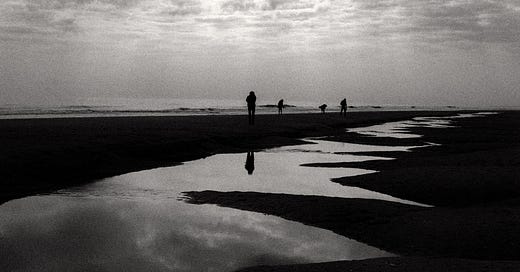Recently, I wrote about the arrival of cold weather and photographing the winter landscape. By the time it posted, I had driven seven hours south to Amelia Island, where temperatures were in the upper 70s and I could walk barefoot on the beach.
I have been going to Amelia routinely for nearly 20 years, visiting in all seasons. December and March are my favorite months, as they fall in the shoulder season with cooler temperatures and there are fewer people around.
Even after all these years of photographing the island, I still get out and about with my camera. Sometimes making photographs is the primary purpose of my trip. Other times, I’m just there to relax, but like to see what has changed, what catches my eye, what I have overlooked before, and what looks compelling in different light. The beach changes daily—what washes ashore, patterns in the sand, reflections in the water, the strength of the waves, the people on the beach. Along Eagan’s Creek, where the salt mash transitions to fresh water marsh, the seasonal change of plants is always of interest, plus I never know which migrating birds, small mammals or alligators I might encounter. Often, I revisit Fort Clinch, seeking out new views of the historic structure. And the maritme forest, with its Spanish-moss-draped live oaks, always calls to me.
This trip, I was intrigued by the deep tidal pools on Fernandina Beach. Though not uncommon, the beach is more often smooth and sandy, with a gentle taper to the ocean. The tidal pools add dimension to an otherwise flat landscape. Their shape, patterns and depth always vary. I started by making a number of photos of light falling on the beach, playing with different angles and compositions, but without the graphic impact I wanted. Then I turned, faced the sun and saw what I was looking for: Strong reflections bouncing off the water. Light and shadow. And people walking up the beach, silhouetted against the sun. I did what Sam Abel recommends: Find good light and wait for something to happen. Eventually, four people walked into position. I caught their different movements and loved that they were each looking at different things. I made several photographs as they moved about.
Except for days when I’m shooting film, I work digitally and shoot in RAW, then convert the files to black and white. If you’ve ever tried this, you know there are many different ways to translate the image. I wanted high contrast for impact. I didn’t want the people to be identifiable. I also wanted something that felt a little gritty—perhaps because there was so much sand, not only on the beach but also blowing around in the air.
For fun, I created half a dozen other versions, as well. In one, I increased both the contrast and structure, which brought out the reflections of clouds in the water and the rays from the sun. While those two areas looked good, I felt they made the photograph too busy overall. I also tried softening the image and toning it a soft brown. The result was interesting, but too soft. I may continue to experiment, but for now, I prefer this higher-contrast version because of the way it emphasizes the striking shape of the tidal pools.
Image capture is just a beginning. How we interpret a RAW file or negative (even if we choose to interpret it as close as possible to what we saw) is a choice that must be made for each photograph. When we work in black-and-white instead of color, we have already abstracted the subject matter. Black-and-white photography is a good way to shift our focus from the subject itself to its more graphic qualities—line, shape, form and texture—and to emphasize light and shadow.
If this newsletter did not arrive in your inbox, click here to subscribe for free:





It so enjoyable reading about the places on Amelia Island you enjoy photographing. My in laws lived there so we visited quite often, enjoying photography as well as beach combing. Your photo of the day brings back all these memories and more. Thank you!
This offered great tips and reasons to return to places you’ve found.